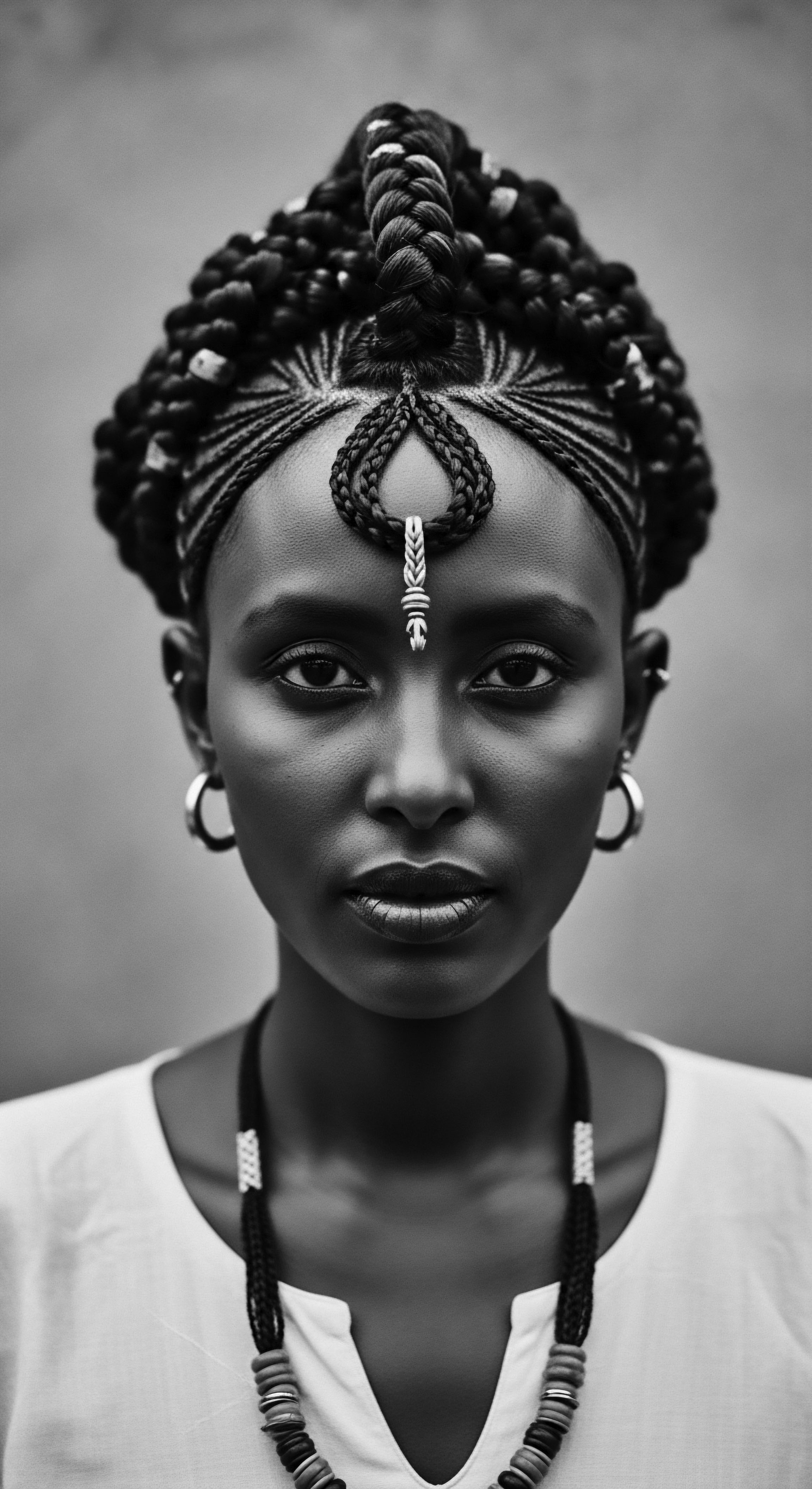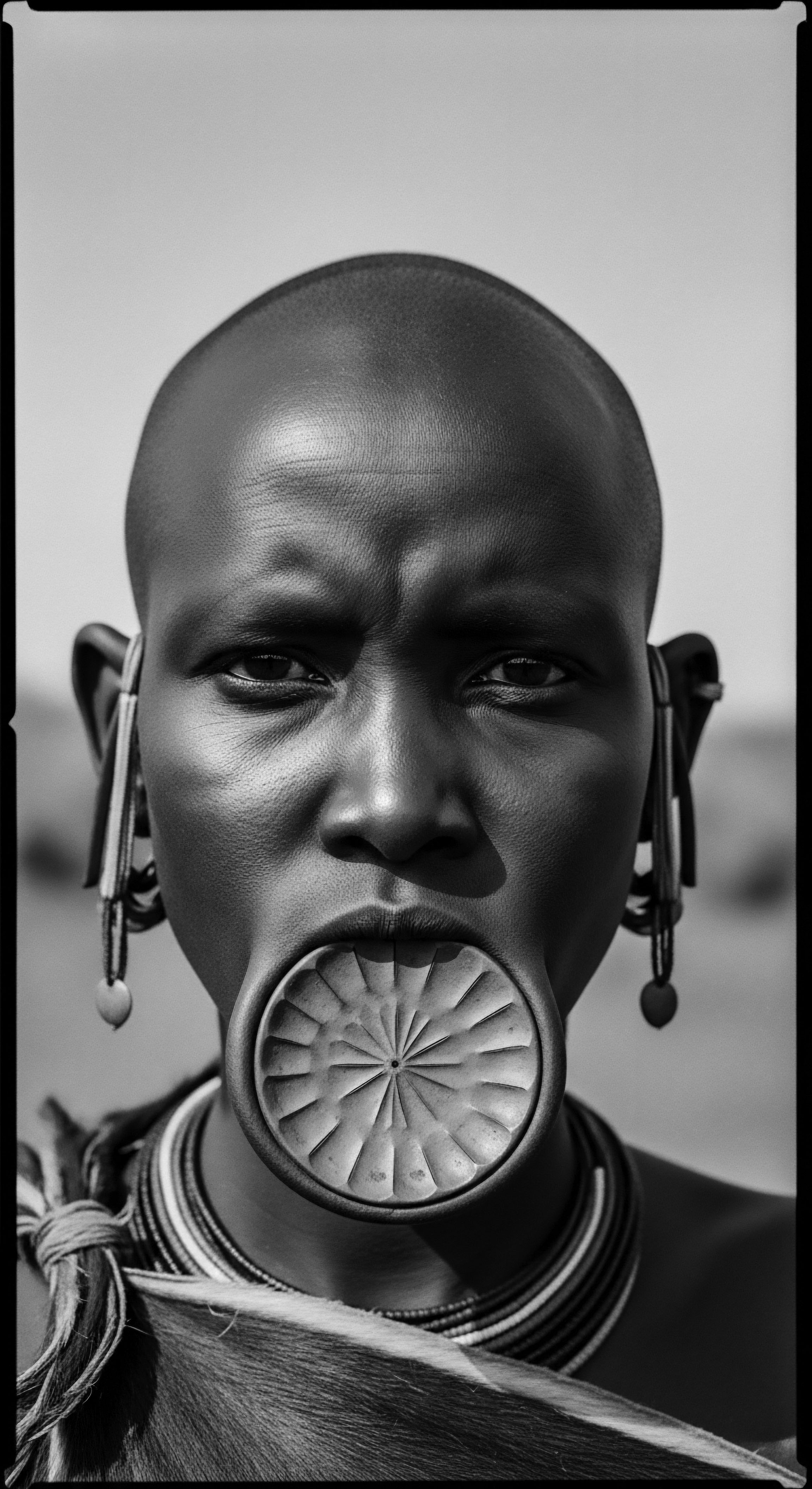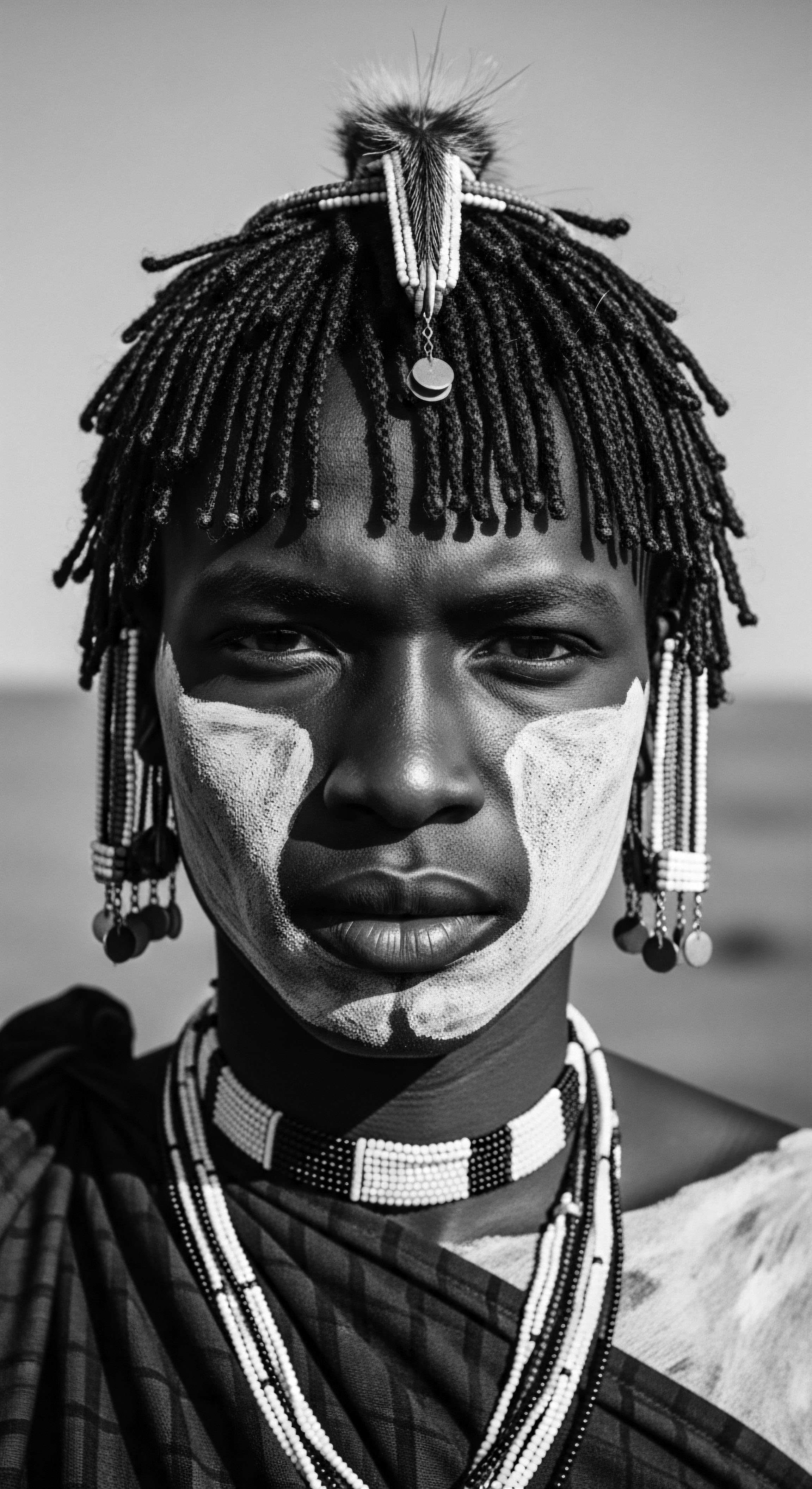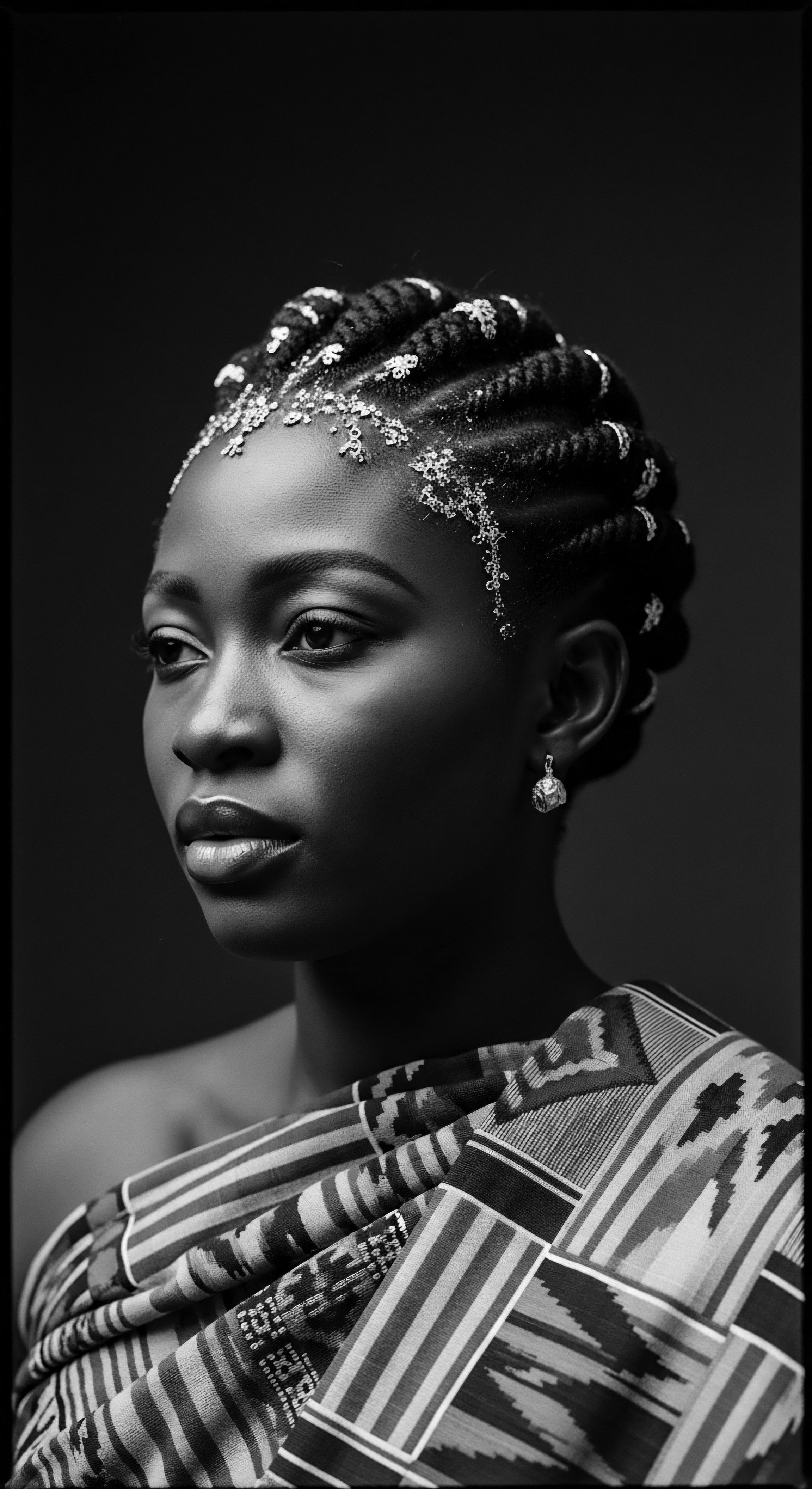
Fundamentals
The term Camwood Adornment speaks to a deeply rooted practice within many African societies, particularly those of West and Central Africa, centered around the revered tree known as Camwood. This botanical gift, primarily derived from species like Pterocarpus soyauxii (African Padauk) or Baphia nitida, yields a rich, vibrant red pigment from its heartwood. This pigment, when prepared in traditional ways, transforms into a cosmetic material, often a powder or a paste mixed with natural oils. Its application extends beyond mere color, serving as a powerful means of expressing identity, marking social status, signifying life stages, and connecting individuals to their ancestral heritage.
From earliest times, this radiant earth tone has offered a tangible link to ancient wisdom, reflecting a profound understanding of the natural world and its ability to nourish not only the skin but also the spirit. The practice represents a living archive of communal memory and aesthetic sensibilities, continually unfolding across generations.
For those new to the depths of textured hair heritage, envision the Camwood Adornment not as a fleeting trend but as a sacred ritual, a language spoken through the body. It symbolizes a connection to the very earth, its hues mirroring the sunsets and the lifeblood that sustains communities. Its presence in hair and on skin is a declaration, a visual story passed down through countless hands, each application reaffirming a cultural narrative.
The Camwood Adornment, a vibrant red pigment from African trees, embodies ancestral wisdom and serves as a powerful expression of identity and heritage, especially for textured hair.

The Earth’s Red Gift ❉ Sourcing and Significance
Camwood, known botanically as Pterocarpus soyauxii or Baphia nitida, stands as a testament to the continent’s rich biodiversity and its long-standing relationship with natural resources. The heartwood, nestled deep within the trunk, holds the potent pigments responsible for its striking red, sometimes orange-red, hue. The process of obtaining this pigment is itself a practice steeped in tradition, often involving careful grinding or rubbing of the wood, transforming it into a fine powder. This powder, historically, would then be mixed with other natural emollients such as Palm Oil or shea butter, creating a paste or pomade ideal for application.
This foundational step in its preparation underscores a philosophy of holistic resource utilization, where every part of the plant holds potential for human wellbeing and cultural expression. The very act of preparing the adornment becomes a connection to the earth’s bounty, a deliberate engagement with raw, transformative materials. This inherent link to the land reinforces the reverence surrounding Camwood Adornment, placing it within a continuum of ecological and cultural stewardship.
- Botanical Roots ❉ Camwood derives from trees such as Pterocarpus soyauxii or Baphia nitida, yielding a deep red pigment from its heartwood.
- Traditional Preparation ❉ The wood is often ground into a fine powder, then blended with natural oils like palm oil or shea butter to form a cosmetic paste or pomade.
- Beyond Pigment ❉ Its application historically extended into ceremonial contexts and daily beautification, signifying status and identity.
- Holistic Resource Use ❉ The traditional sourcing and preparation methods reflect a deep respect for the natural world and its gifts.

Early Uses for Hair and Body
In ancient times, before the modern lexicon of cosmetics, communities across Africa recognized the profound communicative power of adornment. Camwood, with its striking color, became a favored medium. For hair, it was not merely a dye; it was an enhancer, providing a reddish tint that could signify vibrancy or mark a transition. The application of camwood paste to hair, often combined with intricate braiding or styling, served as a public declaration.
It marked individuals for ceremonies, rites of passage, or simply as members of a particular social group. For example, in the Kuba Kingdom of the Democratic Republic of Congo, a powdered form of camwood, known as Tukula, was mixed with palm oil and used to ornament the face, hair, and chest during dances and important ceremonies. This practice highlights how Camwood Adornment transcended the purely aesthetic, becoming an integral component of communal identity and spiritual observance. Its presence on the body, particularly on hair, was a living canvas of cultural narratives.
The earliest documented uses illustrate a spectrum of applications. Beyond hair, it served as a protective balm for the skin, believed to possess antiseptic and anti-inflammatory qualities. Its rich, earthy scent, combined with the grounding sensation of natural oils, contributed to a full sensory experience. This holistic approach to adornment, where beauty was intertwined with wellbeing and cultural meaning, set the foundation for generations of hair care practices.
The deep red coloration also held symbolic weight, often connected to vitality, blood, life, and power in various African cultures. The very act of adorning oneself with camwood was a dialogue with these potent symbols, a reaffirmation of life’s enduring forces.

Intermediate
Moving beyond the initial understanding, the Camwood Adornment reveals its layered significance within textured hair heritage, operating as both a cosmetic agent and a cultural symbol. Its meaning is woven into the very fabric of identity for Black and mixed-race communities, linking contemporary practices with ancestral memory. The deep red tones imparted by camwood are not incidental; they carry a profound cultural resonance, often connected to bloodlines, life force, and the protective spirit of the community.
This connection deepens when one considers the unique needs of textured hair – its inherent dryness, its coiled and curly structures – which benefit from natural emollient treatments. Camwood paste, traditionally blended with nourishing oils, offered a solution for these needs, simultaneously conditioning the hair while imparting symbolic color.
The application of this adornment became a tender act of care, often performed communally, solidifying bonds and transmitting intergenerational knowledge. The act of preparing the mixture, patiently grinding the wood, and carefully applying it to each strand of hair, speaks to a slow, deliberate wisdom. This contrasts sharply with the hurried pace of modern beauty routines, inviting a reconsideration of traditional practices as pathways to holistic wellbeing and deeper connection with one’s heritage.

Pigment and Protection ❉ A Symbiotic Relationship
The distinctive coloration of camwood, often a rich reddish-brown, extends beyond mere visual appeal, embodying protective qualities long recognized in ancestral practices. The active compounds present in the wood, such as Santarubin Pigments, possess properties that historically served to shield both skin and hair. When applied as a paste, often with palm oil, it formed a natural barrier, offering defense against environmental elements. This protective function was especially valuable for textured hair types, which often require careful sealing to retain moisture and maintain structural integrity.
The use of camwood, therefore, was a sophisticated act of natural chemistry, a symbiotic relationship where aesthetic enhancement converged with practical care. It highlights an inherent wisdom in traditional communities regarding hair health, demonstrating an acute understanding of how natural elements could fortify and preserve delicate strands. This dual purpose solidifies its place as an integral component of heritage hair care, where adornment and preservation were not separate endeavors, but rather aspects of a unified approach to wellbeing.
| Traditional Camwood Adornment Preparation ❉ Grinding heartwood, mixing with palm oil or shea butter to form a paste. |
| Modern Hair Care Analogs/Interpretations Formulation ❉ Camwood powder extracted and incorporated into creams, masks, or oil blends. |
| Traditional Camwood Adornment Application ❉ Applied as a vibrant pigment and protective layer to hair and scalp for ceremonies, rites of passage. |
| Modern Hair Care Analogs/Interpretations Function ❉ Used for natural hair coloring, deep conditioning treatments, or scalp masks; often marketed for "natural" hair enthusiasts. |
| Traditional Camwood Adornment Key Benefits (Ancestral) ❉ Symbolism (vitality, status), conditioning, scalp health, UV protection (implied by traditional use). |
| Modern Hair Care Analogs/Interpretations Key Benefits (Contemporary) ❉ Natural color enhancement, antioxidant effects, anti-inflammatory properties for scalp. |
| Traditional Camwood Adornment Community Aspect ❉ Often applied in communal settings, passing down knowledge and solidifying social bonds. |
| Modern Hair Care Analogs/Interpretations Individual Practice ❉ Primarily a personal routine, though sharing recipes and tips happens online. |
| Traditional Camwood Adornment The enduring legacy of Camwood Adornment underscores a continuous quest for beauty and wellness, bridging ancient wisdom with contemporary hair practices. |

Ritual Significance in Textured Hair Traditions
The practice of Camwood Adornment extends far beyond superficial decoration, holding deep ritual significance within numerous African societies. Its presence in hair often marked significant life transitions, acting as a visual testament to the wearer’s journey. For example, among some West African communities, the application of red pigments, including those derived from camwood, played a role in Initiation Rites, marking the passage from childhood to adulthood. The color red, a symbol of life force, transformation, and often protection, was deliberately chosen to imbue the individual with strength as they stepped into new responsibilities.
The preparation and application of the adornment were communal events, often led by elders, reinforcing the collective identity and shared cultural memory. This intergenerational transfer of knowledge ensured that the meaning and methods of Camwood Adornment remained vibrant, linking individuals to a continuum of ancestral practices. Hair, considered a sacred extension of the self and a conduit to spiritual realms in many cultures, became a primary canvas for this profound expression.
Camwood Adornment is not merely cosmetic; its ritual application in textured hair traditions symbolizes life transitions, community bonds, and ancestral protection.
The symbolism of red pigments in African cultures is rich and varied. Across different groups, red could denote danger, daring, or urgency, but also joy, energy, and warmth. In the context of adornment, particularly for hair, it often signaled vitality and a connection to the earth’s generative forces.
The meticulous nature of applying camwood, often intertwined with specific hairstyles for ceremonial occasions, solidified its place as a venerated tradition. These practices provide a window into the holistic worldview of these communities, where beauty, spirituality, and social order are inextricably linked, each strand of adorned hair telling a story of belonging and purpose.

Preparation Wisdom ❉ Crafting the Adornment
The traditional creation of Camwood Adornment reveals an artisanal wisdom, a deep knowledge of natural materials passed down through generations. The process typically begins with the heartwood of the camwood tree, which is meticulously shaved or ground into a fine powder. This laborious step ensures a consistent texture, essential for smooth application. Once powdered, it is common practice to mix the camwood with various natural oils, most notably Palm Oil or shea butter.
These emollients serve multiple purposes ❉ they create a workable paste, enhance the pigment’s adherence, and provide a conditioning effect for the hair and skin. The careful blending of these ingredients, often done by hand, transforms raw botanicals into a potent cosmetic, demonstrating an intimate understanding of their properties. The knowledge of proportions, temperature, and mixing techniques, transmitted through oral tradition and practical demonstration, highlights the sophistication embedded within these ancestral practices. This isn’t a factory process; it’s a living art form, a testament to ingenuity and a profound connection to the earth’s offerings.
- Wood Sourcing and Reduction ❉ Selectively harvesting camwood heartwood and meticulously grinding or shaving it into a fine, consistent powder.
- Emollient Integration ❉ Combining the powdered camwood with natural oils like Palm Oil or shea butter, creating a smooth, rich paste.
- Blending for Consistency ❉ Careful, often hand-mixing to ensure a uniform texture and optimal pigment dispersion for application.
- Scent and Preservation ❉ Sometimes incorporating other aromatic botanicals or natural preservatives to enhance the experience and extend shelf life (though this is less explicit in sources, it aligns with broader traditional practices).

Academic
The academic understanding of Camwood Adornment transcends its simple definition as a cosmetic, positioning it as a complex cultural artifact, a bio-active substance, and a powerful semiotic marker deeply embedded within the heritage of Black and mixed-race hair experiences. From an ethnobotanical standpoint, Camwood Adornment refers to the prepared pigment derived from the heartwood of certain Pterocarpus species, primarily Pterocarpus soyauxii (African Padauk) or Baphia nitida, traditionally utilized across West and Central African societies for its distinctive red coloration. This pigment is typically rendered into a fine powder, then commingled with natural lipids, such as palm oil or shea butter, forming a paste or pomade.
Its significance extends into realms of anthropology, sociology, and even cosmetic science, revealing how ancestral practices intuited properties now validated by modern inquiry, and how aesthetics function as profound expressions of identity and social cohesion. This deep investigation into the historical trajectories and nuanced applications of Camwood Adornment offers a critical lens through which to appreciate the enduring resilience and self-determination evident in textured hair heritage.

Ethnobotanical Delineation ❉ The Source and Its Compounds
From an ethnobotanical perspective, the identity of Camwood primarily centers on trees within the Fabaceae family, most notably Pterocarpus soyauxii, often recognized as African Padauk, and Baphia nitida. These species are indigenous to the lush forest regions of West and Central Africa, serving as the biological wellspring for the famed red pigment. The critical component resides within the heartwood, which, upon processing, yields a vibrant red or reddish-orange powder. Chemical analyses of these species reveal the presence of unique compounds, including Santarubin Pigments, which are responsible for the rich, stable color.
Beyond their chromatic properties, these compounds are increasingly recognized for a spectrum of bioactive qualities. Traditional applications often linked camwood to skin health, suggesting inherent antiseptic, antibacterial, and anti-inflammatory attributes. This ancient understanding, rooted in empirical observation, now finds corroboration in contemporary scientific research examining the phytochemistry of these botanicals. The meticulous preparation of the wood, often through grinding or shaving, reflects an indigenous botanical knowledge, transforming raw material into a functional cosmetic and therapeutic agent.
This process highlights a sophisticated understanding of plant properties and their synergistic interaction when combined with natural oils like palm oil, creating a durable and nourishing compound. The wisdom embedded in these preparation methods, passed down through generations, attests to a sustained engagement with natural pharmacology within these communities, long before the advent of modern laboratories.

The Semiotics of Pigment ❉ Red’s Cultural Resonance
The coloration imparted by Camwood Adornment—a rich spectrum of reds and reddish-browns—is profoundly semiotic, serving as a powerful visual lexicon within African cultural contexts. Across numerous West and Central African societies, red pigments, whether from camwood, ochre, or other natural sources, carry layered meanings that transcend mere decoration. These meanings are often deeply intertwined with concepts of life, vitality, blood, transformation, and protection. For instance, in many communities, red is associated with life-giving forces, energy, and the sacred nature of existence.
It can symbolize the daring spirit of warriors, the lifeblood of a lineage, or the warmth of a community. The application of Camwood Adornment to textured hair, which itself holds significant cultural and spiritual importance in many African belief systems, amplifies these symbolic declarations. Hair, often considered a conduit to spiritual realms and a reflection of social status and identity, becomes a living canvas for these potent messages. In the Yoruba culture of Nigeria, for example, hair is profoundly connected to the concept of Orí, representing an individual’s destiny, thus the care and adornment of hair are not taken lightly.
The integration of a color so imbued with life and ancestral power speaks to a conscious intent to imbue the wearer with these qualities. This signifies a sophisticated visual language, where an adorned hairstyle communicates complex narratives about personal identity, communal belonging, and spiritual alignment. It is a testament to how traditional beauty practices function as integral components of a society’s philosophical and social framework.
The nuanced understanding of red’s symbolism varied across groups, reflecting distinct local interpretations and ritual applications. In some contexts, it indicated a state of transition, such as during rites of passage for young men and women. The bold presence of red on the body and hair could mark an individual as prepared for new societal roles, signifying their courage and readiness to embrace the next phase of life. The material itself, Tukula in the Kuba Kingdom, was not merely a cosmetic but also used to anoint the dead, linking life and ancestry in a continuous cycle.
This dual application underscores the profound connection between life, death, and spiritual continuity inherent in the use of camwood, rendering it an almost sacred substance. The consistency of these symbolic associations across diverse ethnic groups highlights a shared cultural grammar, where color becomes a language articulating identity, status, and spiritual connection within and between communities.

The Science within Ancestral Lore ❉ Validating Traditional Efficacy
The ancestral knowledge surrounding Camwood Adornment, often transmitted through oral tradition and practical application, demonstrates an astute empirical understanding of its properties, which contemporary science has begun to validate. Beyond its aesthetic appeal, the traditional use of camwood for hair and skin care was rooted in observations of its tangible effects. For centuries, practitioners noted its ability to soothe skin, deter certain ailments, and condition hair. Modern phytochemical research has begun to identify the specific compounds within Pterocarpus soyauxii and Baphia nitida that contribute to these benefits.
For instance, the presence of certain Flavonoids and Phenolic Acids in related Pterocarpus species has been linked to antioxidant, anti-inflammatory, and antimicrobial activities. This scientific validation underscores that traditional applications of camwood were not arbitrary; they were sophisticated forms of natural pharmacology, leveraging the inherent bio-active properties of the plant for holistic wellness. The combination of camwood powder with nourishing oils like palm oil, a staple in many West African hair care regimens, not only aids in pigment dispersion but also provides fatty acids and vitamins that are beneficial for scalp health and hair moisture retention. The practice of creating camwood pastes speaks to an intuitive cosmetic science, where the physical form of the adornment was optimized for both efficacy and sensorial experience. This convergence of ancient wisdom and modern scientific insight reveals a continuous thread of hair understanding, where ancestral lore offered practical solutions to complex dermatological and trichological challenges, reflecting a deep respect for both the body and the natural world.
Ancestral Camwood Adornment practices, once passed through oral tradition, now find scientific validation in their plant compounds, revealing sophisticated natural pharmacology.
A compelling instance of this scientific underpinning within ancestral practice can be observed in the traditional use of camwood for treating various skin conditions and even for its purported effects on hair discoloration or baldness in some traditional medicinal contexts across Africa. While direct, large-scale clinical trials on Pterocarpus soyauxii for textured hair growth are still emerging, the broad recognition of Pterocarpus species in African ethnobotany for hair-related issues, including as a hair colorant and for general hair care, is documented. For example, a review on cosmetopoeia of African plants notes Pterocarpus soyauxii bark is traditionally macerated or crushed and applied to the scalp as a Natural Dye for hair, also highlighting other Pterocarpus species used for baldness and hair tinea treatments. This reinforces the idea that communities actively utilized these plants for their perceived medicinal and beautifying properties, demonstrating a form of empirical inquiry.
The consistent application of these botanicals for specific dermatological and hair concerns across various regions provides anecdotal evidence that, when examined through a modern lens, often points to the active biochemical properties of the plant materials. This profound engagement with the natural world, transforming its gifts into potent solutions for health and aesthetics, illustrates the deep scientific wisdom inherent in ancestral practices. The effectiveness was experienced and understood within a cultural framework that prized balance and connection to the earth.

Sociocultural Resilience ❉ Camwood Adornment as Identity
The enduring presence of Camwood Adornment in contemporary Black and mixed-race hair experiences speaks volumes about sociocultural resilience, functioning as a tangible link to heritage despite centuries of colonial influence and systemic attempts at cultural erasure. Its persistence as a beautification and ritualistic element underscores a profound commitment to ancestral identity. For many, choosing to incorporate camwood, or practices inspired by its traditional uses, into modern hair routines is a deliberate act of reclaiming and celebrating a lineage that extends far beyond contemporary beauty standards. The very act of preparing and applying this adornment becomes a personal ritual of connection, an intimate dialogue with the past.
It offers a counter-narrative to imposed ideals of beauty, asserting the inherent beauty and cultural richness of textured hair and the traditions that nourish it. This is particularly salient in diasporic communities, where the active seeking out of ancestral practices provides a powerful means of anchoring identity and fostering a sense of belonging in a world that often marginalizes Black hair. The widespread adoption of natural hair movements in recent decades, for example, has seen a resurgence of interest in traditional African ingredients and methods, with camwood being among those rediscovered and re-contextualized for modern use. This reflects a conscious choice to honor the ingenuity of those who came before, recognizing their wisdom as vital for both physical and spiritual wellbeing. The adornment thus becomes a symbol of enduring pride, a vibrant testament to the strength and beauty of a people’s historical journey, continually adapting yet retaining its intrinsic meaning.
| Region/Cultural Group Kuba Kingdom (DR Congo) |
| Camwood/Red Pigment Application for Hair Tukula, powdered camwood mixed with palm oil, applied to hair, face, and chest for dances and ceremonies. Symbolism tied to beauty, health, and ritual significance. |
| Region/Cultural Group Yoruba (Nigeria/Benin) |
| Camwood/Red Pigment Application for Hair Camwood powder (Osun) used for body and hair, often mixed with palm kernel oil, signifying beauty and sometimes ritual purification. Red pigments used in ceremonies, like for the god Oranmiyan. |
| Region/Cultural Group Igbo (Nigeria) |
| Camwood/Red Pigment Application for Hair Red camwood powder or paste, often mixed with palm oil, used as part of elaborate hairstyles like Ojongo, signifying identity, status, and age. |
| Region/Cultural Group Maasai (East Africa) |
| Camwood/Red Pigment Application for Hair While often using red ochre mixed with animal fat for hair applications, the symbolic meaning of red (rebirth, strength, courage) aligns with the broader significance of camwood in other cultures, applied especially to warriors' heads during ceremonies. |
| Region/Cultural Group Nuba Mountains (Sudan) |
| Camwood/Red Pigment Application for Hair Young women coated their bodies with oil and red ochre between puberty and their first pregnancy, signifying stages of life, a practice resonating with camwood's role in marking transitions. |
| Region/Cultural Group The varied yet consistently meaningful application of red pigments across African communities demonstrates a shared cultural language through adornment, connecting individuals to their heritage and communal narratives. |

Reflection on the Heritage of Camwood Adornment
The journey through the intricate layers of Camwood Adornment reveals more than a historical cosmetic; it uncovers a profound meditation on textured hair, its enduring heritage, and the meticulous care it has received through generations. This adornment stands as a living, breathing archive, echoing wisdom from the source, nurturing through tender threads of community, and articulating unbound expressions of identity. The very act of engaging with camwood, whether in its traditional preparation or through modern interpretations, serves as a poignant reminder of our deep-seated connection to the earth and the ancestral knowledge that continues to inform our understanding of beauty and wellbeing.
It invites us to pause, to listen to the whispers of the past, and to recognize the inherent value in practices that prioritize holistic care over fleeting trends. The vibrant red pigment, a gift from the forest’s heart, thus becomes a symbol of resilience, a testament to the cultural richness that textured hair embodies.
For those of us navigating the complex landscapes of Black and mixed-race hair experiences today, the legacy of Camwood Adornment offers not only practical insights into natural care but also a spiritual anchoring. It reminds us that our hair is not merely a collection of strands; it is a repository of history, a canvas for self-expression, and a powerful link to a heritage that is both ancient and ever-present. The traditional ways of preparing and applying camwood speak to a philosophy of self-care rooted in intention, patience, and connection. This ethos calls upon us to view our hair routines as sacred moments, opportunities to honor the ingenious practices of our forebears and to deepen our relationship with our own inherent beauty.
In every carefully applied stroke, in every softened coil, the story of a lineage unfolds, affirming the strength and unique splendor of textured hair across time and space. The enduring significance of Camwood Adornment thus rests not only in its tangible effects but in its capacity to continually inspire pride, connection, and a timeless appreciation for the soul of a strand.

References
- Barksdale, C. (n.d.). African Culture Face and Body Art.
- Cole, H. M. & Aniakor, C. C. (1984). Igbo Arts ❉ Community and Cosmos. University of California Press.
- Gröning, K. (1998). Body Decoration ❉ A World Survey of Body Art. Vendome Press.
- Kalu, O. U. (1999). The Embodied Word ❉ Igbo Protestants and the Creation of an African Public Sphere. Africa World Press.
- Oyetade, S. O. (2004a). The Yoruba from Prehistory to the Present. Cambridge University Press.
- PROTA (Plant Resources of Tropical Africa) Database. (n.d.). Pterocarpus soyauxii.
- Shepherd Textiles. (n.d.). Dyeing with Camwood (Baphia nitida).
- Ukwu, O. I. (2000). The Igbo of Nigeria ❉ A Cultural and Historical Perspective.
- Willis, R. (1989). The Shadow and the Act ❉ The Anthropological Work of Mary Douglas. Routledge.
- Ekpudu, V. I. (2018). Healthy Hair Care Practices ❉ Caring for African Hair Types. Journal of Medical Sciences and Technology, 1(1), 1-6.
